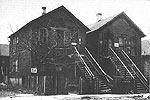
Grand Boulevard
— Washington Park (continued)
Fully three-fifths of Chicago's black residents lived in Grand
Boulevard and Washington Park in 1930, and both neighborhoods
continued to increase in population during the next twenty years.
The subdivision of apartments into kitchenettes contributed
to
overcrowding in the area, and these conversions seriously affected
the quality of neighborhood life. While the east section of
Grand
Boulevard retained its prestige as a black "Gold Coast,"
the western edge of the neighborhood, especially along Federal
Street, continued to deteriorate (See Fig. 1). The
situation in Washington Park was much the same. Although the
apartments nearest the park were of fairly recent origin, illegal
conversions
had turned much of the neighborhood into little more than a rooming-house
district.
Just as Grand Boulevard and Washington Park felt the effects
of black Southern migration during World War I, the area continued
to attract newcomers from the Deep South during World War II.
By 1950 nearly 175,000 black people lived in these twin communities,
an incredible density for a district without highrises. As white
neighborhoods on Chicago's South Side changed racially in the
1950s, the market for black homeowners expanded. The exodus of
middle-class black families from Grand Boulevard and Washington
Park had important consequences for the stability of this part
of the South Side. While many families returned to the area for
worship on Sunday, local businesses did not command the same loyalties
as churches. The district's public schools also were affected.
Du Sable High School at 4934 S. Wabash Avenue had been the pride
of the black community since its opening in 1935. By the late
1950s, however, the school was losing many of its best students
to newly integrated high schools located further south in the
city.
Redevelopment in Grand Boulevard-Washington Park occurred in
the form of two public improvement programs, the Robert Taylor
Homes and the Dan Ryan Expressway. Over the years housing surveys
had documented deteriorated conditions in the Federal Street corridor,
and it came as no surprise to residents that city planners described
their homes as "slum and blighted." In the 1950s the
Chicago Housing Authority inaugurated a new policy of building
high-rise public housing projects. These elevator buildings soon
replaced vast stretches of single-family dwellings, apartments,
and businesses in the city's original Black Belt. In 1958, for
example, eight high-rises of the Stateway Gardens project were
completed in the area bounded by 35th, State Street, Pershing
(39th), and the Rock Island railroad tracks. Two years later construction
began on the Robert Taylor Homes, now recognized as the world's
largest public housing project.
«
previous
12
of 14
next
»
|
 |

|
 |


Figure
1: Frame houses, 3903-5 S. Federal. »
|